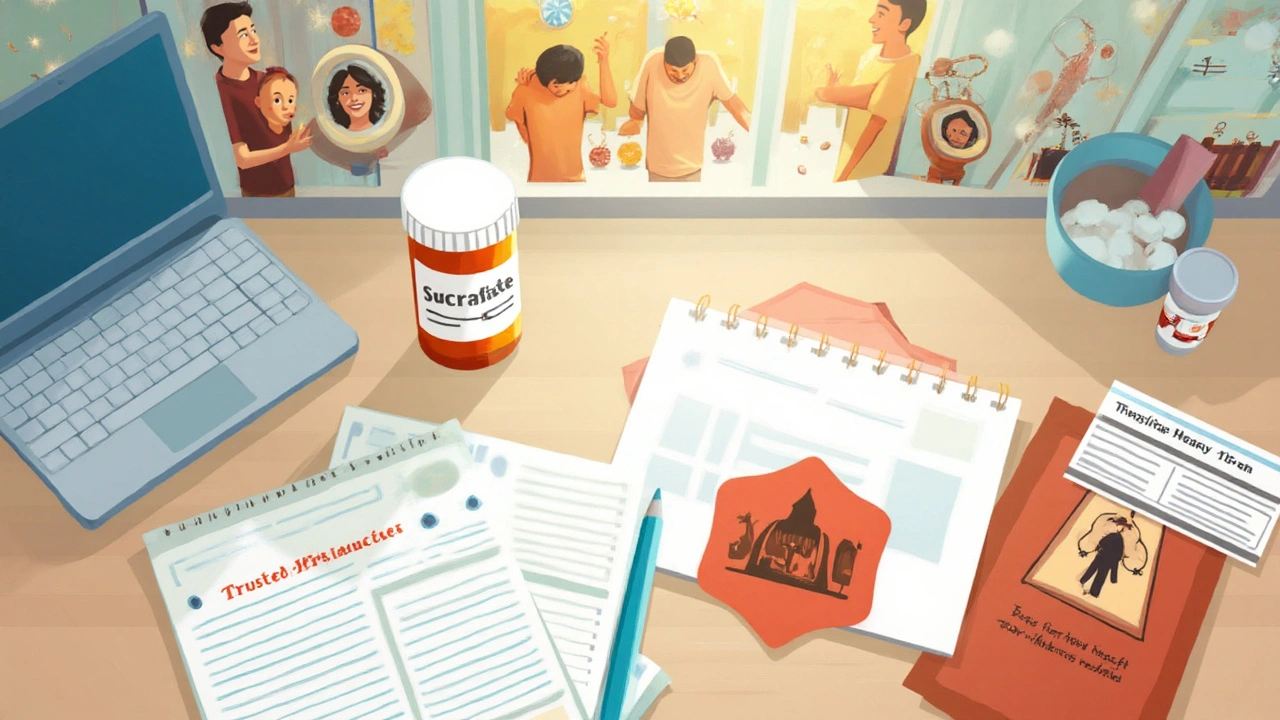Imagine scrolling through your pharmacy’s app at midnight, hoping for a simple answer to that gnawing stomach ulcer pain. You keep hearing the name Sucralfate, maybe from your doctor or those late-night support group posts. Suddenly, you’re knee-deep in search results and every click seems sketchier than the last. Sound familiar?
What is Sucralfate and Why Is It Prescribed?
Sucralfate isn’t one of those meds you see in glossy magazine ads or plastered across billboards. It’s a workhorse though, mostly handed out for people with ulcers—not the mouth kind, but the kind that make your stomach lining feel like an angry cat (trust me, Oki’s swats are nothing compared to acid). Sucralfate forms a protective barrier, giving your gut lining some breathing room so it can heal. Doctors also reach for it when dealing with certain esophagus issues, like in folks with serious reflux problems from stuff like feeding tubes or long-term medications.
Here's a quick breakdown of what makes Sucralfate tick:
- Class: Gastrointestinal agent (think: stomach protector, not acid reducer)
- Often used to treat: Peptic ulcers, stress ulcers, mouth sores (yep, some people use it as a swish and spit rinse)
- Comes as: Tablets and liquid suspension
- Prescription status: Prescription only in most countries, though some regions are experimenting with over-the-counter sales
Something I found fascinating after dodging error messages on a dozen pharmacy websites: Sucralfate doesn’t just neutralize acid like some of the blockbuster heartburn pills. It actually sticks itself to ulcers, working as a tiny suit of armor. That’s why it’s best taken without food—food can “dilute” the barrier. Not too long ago, a study in the American Journal of Gastroenterology showed that patients who actually followed timing instructions for Sucralfate saw healing rates jump by up to 30%. There’s your first tip: take it on an empty stomach, usually an hour before meals.
How to Spot Legitimate Online Pharmacies for Sucralfate
Shopping for prescription meds online is kind of like picking produce at the grocery store—if it looks too shiny, it’s probably waxed. When you see ads promising “No Prescription Needed!” for Sucralfate, take a pause. In a recent 2024 report from LegitScript, 67% of sites selling prescription meds without asking for your doctor’s note were found to be fraudulent or distributing counterfeits.
If you’re serious about protecting your health (or your wallet), keep these points in mind:
- Check for certifications: AAC (the Alliance for Safe Online Pharmacies), LegitScript, or VIPPS badges are great signs. You can click those for verification on the certifier’s site—real ones don’t just slap a JPEG up.
- Require a prescription: Any real online pharmacy will ask to see your prescription. Some even offer telehealth consults, but they won’t just punch in “tummy ache” and send you a bottle.
- Clear contact information: If the site buries their support info or lists only a weird web form, that’s a red flag.
- Physical address: Look for a real-world pharmacy address—bonus points if it matches Google Maps and isn’t next to an abandoned carwash.
- Secure website: HTTPS isn’t just for online shopping—it’s for privacy, especially when you’re plugging in sensitive medical info.
Here’s a fact that’ll stick: according to a 2023 study published in JAMA Network Open, over 20% of medications from unverified sites contained the wrong active ingredient or none at all, so don’t get lured by ultra-low prices.

Where Can You Order Sucralfate Online?
I wish I could just name-drop a single perfect website, but laws vary so much by country. Still, a handful of verified, international platforms are a good start—some even ship to multiple regions, depending on your doctor’s prescription. Here are a few real names that popped up again and again when I was researching meds for Tobias last spring:
- HealthWarehouse (U.S.)—VIPPS certified, always asks for a real script
- Canada Pharmacy—requires prescription upload and shows clear licensing
- PharmaDirect (UK)—linked to local brick-and-mortar stores
Most national pharmacy chains, like CVS and Walgreens in the U.S., now offer online prescription refills and home shipping, including for Sucralfate tablets and suspension. Just keep in mind: not every site delivers internationally. You’ll have to double-check which countries they ship to. For folks in Europe, Boots and Lloyds Pharmacy are reliable picks with decent prices. If you’re in Australia, Chemist Warehouse is well-known and easy to use.
Here’s a little price comparison I put together after endless scrolling. (All prices are for reference as of July 2025, because, you know, things shift.)
| Pharmacy | Package Size | Approx. Price (USD) |
|---|---|---|
| HealthWarehouse | 120 tablets (1g) | $55 |
| Canada Pharmacy | 90 tablets (1g) | $70 |
| Chemist Warehouse | 100 tablets (1g) | $80 (AUD) |
| Lloyds Pharmacy | 60 tablets (1g) | £45 |
Remember, these are all for the same generic Sucralfate—no fancy brands. Prices don’t include shipping or taxes, and you’ll need that prescription scanned or uploaded. Oh, and steer clear of any online vendors selling Sucralfate as a “research chemical.” That’s not just sketchy, it’s illegal in most places with real consequences.
Tips for Getting a Valid Prescription and Smooth Ordering Process
First, don’t self-diagnose. Seriously. Your doctor needs to rule out other issues before tossing a prescription your way—sometimes persistent tummy problems mean you need something more than just a protective barrier. If you’re due for a refill and your clinic offers e-prescribing, ask if they’ll send the script directly to your pharmacy’s website. It saves so much back-and-forth.
If you’re using an online telemedicine provider—which is becoming more common—make sure their physician is licensed to practice in your state or country. Look for video, phone, or safe messaging visits. Once you have your prescription, check if the online pharmacy offers:
- Prescription uploads—usually a scan or clear smartphone picture does the job
- Automatic refill reminders—saves you from scrambling at the last minute
- Secure payment methods (credit card, PayPal)
- Package tracking—a must if you want peace of mind that Sucralfate is en route
- Discreet packaging—so your neighbors aren’t nosing around
If you have insurance, some online pharmacies work directly with major carriers. That means you can use your benefits to cover part or all of the cost, just like you would at a regular pharmacy. If not, ask about discount programs or coupons. Funnily enough, some chains let you stack manufacturer coupons with their own pharmacy promotions. Never hurts to ask! And a note for my fellow chronic illness folks: some sites offer patient assistance or pay-over-time plans, which can be a lifesaver if you’re ordering big quantities every month.

Risks, Safety, and What to Watch For When Buying Sucralfate Online
There are real scams out there, but so many people do buy prescription meds online safely—just don’t go in blind. Here’s what you should watch for:
- Websites selling without any prescription requirement
- Unusually low prices or discounts that seem too good to be true
- No way to contact real customer service or pharmacists for questions
- Strange payment requests, like gift cards or wire transfers—big no
- Sites with lots of spelling errors or shoddy design, which usually signals they rushed setting up shop
If you’re ever unsure about a site, the U.S. FDA actually runs a website called BeSafeRx, where you can check online pharmacy legitimacy. One more tip: when your Sucralfate arrives, make sure the packaging is sealed, not expired, and the medication matches what your doctor ordered. Generic drugs should include the manufacturer’s information and a batch number (a string of letters and numbers on the bottle or box—never ignore a missing one).
A National Institutes of Health (NIH) review back in 2022 found that counterfeit medications, especially for less “mainstream” prescriptions like Sucralfate, are most common in unregulated online markets. Fakes sometimes have fillers or wrong dosages—pretty risky if you really need gut healing. Don’t risk your stomach lining for a bargain; peace of mind matters more.
If anything’s off, call your pharmacy’s help desk or your doctor right away. And trust your gut (pun intended): if a site feels sketchy, move on.
Sean McCarthy
August 7, 2025 AT 09:56Sucralfate works by sticking to ulcers like glue not acid neutralizer
Courtney Co
August 7, 2025 AT 10:01I bought some from a site that said no prescription needed and got a bottle of chalk powder and a note that said 'hope you feel better lol' I'm still mad I spent 70 bucks on that
Shashank Vira
August 8, 2025 AT 00:37One cannot help but observe the profound existential irony of modern medicine: we have the biochemical capacity to synthesize protective mucosal barriers yet we outsource our health to algorithm-driven storefronts where trust is a commodity traded in discounted tablets. The real ulcer is not in the stomach but in the erosion of institutional trust.
Eric Vlach
August 9, 2025 AT 09:26Just want to say if you're using HealthWarehouse or Canada Pharmacy make sure your script is clear and legible I had one rejected because the doctor wrote 'sucralfate' like a cursive S and the system thought it was 'sugarlate' took three days to fix
Souvik Datta
August 10, 2025 AT 03:37There's a quiet dignity in taking care of yourself with something as simple as sucralfate. No flashy branding no viral TikTok trends just a plain tablet doing its job. If you're reading this and you're struggling with chronic pain know this you're not alone and the fact that you're seeking safe options already makes you stronger than most. Keep going. One pill at a time.
Priyam Tomar
August 10, 2025 AT 19:03Everyone keeps talking about HealthWarehouse like it's the holy grail but did you know they source from India and the FDA doesn't inspect all their facilities? And don't get me started on Canada Pharmacy they're technically legal but their 'pharmacists' are just call center workers who read from a script. You think you're safe but you're just gambling with your gut
Kay Lam
August 12, 2025 AT 02:41I had a really bad experience with a site that looked legit but turned out to be a phishing site that stole my insurance info and then sent me a box of what looked like crushed aspirin mixed with glitter I called my doctor and he said he'd never heard of that brand and then I spent three weeks in the ER trying to convince them I didn't take anything illegal which is ironic because I was just trying to treat my ulcer and now I have anxiety about opening any package that doesn't have a barcode I swear I'm not paranoid I just want to be safe
Matt Dean
August 12, 2025 AT 22:14Why are people still buying online at all just go to CVS they have a drive thru and if you're on Medicaid they'll give you a 90 day supply for five bucks you're literally making this harder than it needs to be
Walker Alvey
August 13, 2025 AT 11:39Wow you spent 70 dollars on chalk and now you're crying about it